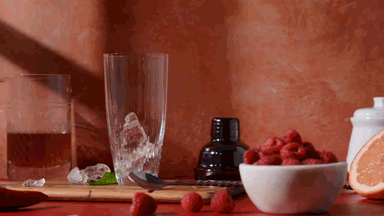There are several camera sliders on the market that work with Dragonframe. Being compatible with Dragonframe means you can control its movements within the app while animating.

The only problem is that Dragonframe-compatible sliders can be prohibitively expensive for regular animators. But the good news is you can always use a traditional slider with a little bit of patience and creativity.

In one of our articles, we taught you how to use a manual slider to create action shots. But this time, we'll show you how to create smooth camera movements with an electric slider without any modifications.
What are the advantages of using an electric slider?
It's automated
The main advantage of using an electric slider is that you don't have to touch it to move it. Instead of using your hands to control the slider, you can use a remote to activate its stepper motor.
It's precise
Stop motion is all about precision. When you move a slider using your hands, your adjustments wouldn't always be accurate. And you could quickly end up with shaky footage if you slide the camera just a few millimeters off.
Using a motorized slider ends the guessing game since you can move it in precise increments. Since it's a machine, you don't have to worry about adjustment errors on your side.
It has remote control
Most motorized sliders have a remote control, and the more expensive versions even include an app that lets you adjust parameters using your phone.
Since you can adjust everything from a distance, you don't have to walk from your shooting table to your slider every time you have to shoot a frame. Consequently, it decreases your chances of accidentally knocking off your animation set or the camera itself.
How do you use an electric slider for stop motion?
Electric sliders vary in features, but the one you'll need for stop motion is Timelapse Mode. This function will be necessary for controlling camera movements while animating.
For this project, we used a cheap GVM Slider which we bought some time ago for about 300+ USD. But any other motorized option with Timelapse Mode will work fine as they often offer similar features.
Keep in mind that sliders will have different controls as far as Timelapse Mode is concerned (just like cameras have differing button placements). But for the most part, they all should work the same, and you should be able to apply what you learn here on practically any motorized slider with a Timelapse function.
Step 1: Set up your slider and camera.
You typically attach your camera to your slider with a wired trigger for regular timelapse. The wire allows the slider to command the camera to take a photo every time it moves.

But you don't have to attach this wired trigger to your camera for stop motion since you will be triggering the shutter yourself independently via Dragonframe. So all you have to do is install your camera on your slider, and you're good to go!
Step 2: Go to Timelapse Mode and Change the Settings.
You can often find the Timelapse Mode in the main menu of your slider remote or app, among the other options that typically include Video Mode and Panorama.

Once you access the Timelapse Mode, you'll need to change the parameters to make it easier for you to animate.
You need to pay attention to the three main settings we listed when using your electric slider for stop motion. Remember that they may be under different names depending on your slider.
Speed refers to how fast the slider moves. For time-lapses, it can vary from a few seconds to hours.
Our slider remote displays the Speed in percentage instead of the actual time it takes for the slider to go from Point A to Point B.
To determine the best percentage, you can enter a value and time the slider as it moves from Point A to point B. If it's too slow, increase the rate. If it's too fast, decrease it.
Keep adjusting the speed until you reach the value closely matching the time you want the camera to move while animating. Remember that your animation is only a few seconds long, so your slider movement should also move just as long.
It takes some trial and error to calibrate the Speed. But once you figure out the correct percentage, it will become easier to guess which values to use for different speeds.
Interval is the number of times the camera stops as it travels on the slider from Point A to Point B. It can be anywhere from less than a dozen stops to a few hundred.
If you want to capture smooth movement, choose the smallest interval. When the camera travels only a few millimeters at a time, it can capture more frames that result in buttery footage.

On the other hand, if you choose long intervals, the considerable gap between shots could result in jerky movement, as you can see in the sample clip below.

Shooting Interval determines the time it takes for the slider to pause between intervals. It's usually at this moment the camera takes a photo since the slider is still.
The Shooting Interval depends on your camera's shutter speed. If you're shooting with a shutter speed of 1/15th of a second, you must ensure the shooting interval doesn't go any faster than that shutter speed setting.
We recommend choosing a shooting interval value a few seconds slower than your shutter speed. That way, you give the slider enough time to stop before the camera takes a photo and enough time to resume moving after it takes a shot.
Step 3: Start animating!
Animating with a slider (motorized or not) requires a lot of concentration because, in essence, you're animating two separate elements: The product and the slider itself.

The secret is to move everything sequentially, so you don't forget if you've moved something. By this, we mean to move the product first, then the slider (or vice versa).
Don't go switching tasks, as it can become confusing. It would also help to playback your animation to ensure you didn't forget to move the camera or the product.
Since you're working with a slider incompatible with Dragonframe, you'll also need to control the slider yourself.
Once you start the Timelapse on your slider, you need to watch it move. As it stops, you'll need to press Pause on your slider remote immediately. That way, the slider doesn't move before you can even take a picture.
Once the slider is in Pause, use your Dragondrame remote pad to trigger the camera and take a picture.
After you've taken a photo, press Play on your slider's trigger and wait for it to move again.
When the slider moves again, press Pause once more, take a photo, and repeat the process until you finish your animation!
Working with a motorized slider indeed seems complicated, especially since you have to use separate remotes for the slider and Dragonframe. But once you get used to the process, you'll find that it produces smoother results than simply using a manual slider.
Using a motorized slider also ensures you get precise movements every time. That way, you don't have to manually move the camera, praying you don't mess up! So despite the extra steps you need to take, at least you'll have less human error to worry about.
Also, did you know you can modify an existing motorized slider to make it compatible with Dragonframe? We'll show you how to do it in the future, so stay tuned!